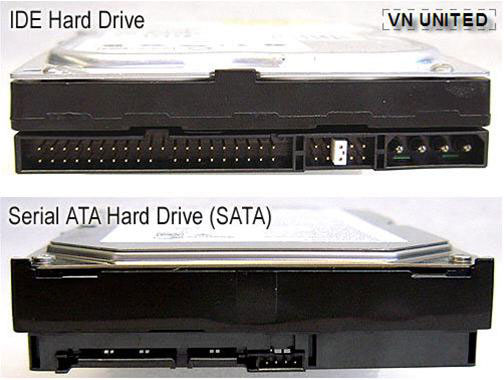Part I: Hard drive connection standards
Hard drives are an indispensable component of a computer system. It is a place to store the operating system, install software, utilities as well as store data for use.
Basic understanding of hard drives will help you use them better.
The article is not intended to introduce in detail the components, parts or operation inside the hard drive but gives you an overview of the common types of hard drives today, how to connect to the system, install and use.
Connection standards: IDE and SATA
Currently the internal hard drive has two common connection standards: IDE and SATA. When you want to buy new or add a new hard drive to your computer, you need to know which motherboard supports the connection standard. The motherboards that have been produced for the last 2 years will be able to support both of these connection standards, and the motherboards will only support IDE in advance. You need to see more information attached instructions of the motherboard you are using or contact the manufacturer to know exactly the connection standard that it supports.
IDE (EIDE)
The Parallel ATA (PATA), also known as EIDE (Enhanced intergrated drive electronics), is known as a popular hard drive connection for more than 10 years. Maximum data transfer rate is 100 MB / sec. The latest motherboards are almost completely removed from this connection standard, however, users can still purchase the PCI EIDE Controller if they want to use the EIDE hard drive.
SATA (Serial ATA)
Quickly becoming the new connection standard in hard drive technology thanks to superior capabilities over IDE standard for data processing and transmission speed. SATA is the result of noise reduction, increasing the airflow in the system due to 400% narrower SATA cables than IDE cables. Maximum data transfer rate up to 150 - 300 MB / sec. This is why you should not use a generic IDE hard drive with a SATA hard drive on the same system. The IDE hard drive will 'pull' the speed of the SATA hard drive as much as it does, making the SATA hard drive not work properly with its 'power'. Today, SATA is the most popular standard hard drive connection and, as above, we can apply the PCI SATA Controller card if the motherboard does not support this connection standard.
You can rest assured that Windows 2000 / XP / 2003 / Vista versions or software will recognize and be compatible with both IDE and SATA hard drives. However, the way they are installed on the system is different. Therefore, you need to know how to distinguish between IDE and SATA hard drives so that you can install them on your system when necessary. The simplest way to distinguish is to look at the back of the hard drive, its connection part.

Rear connection interface of IDE and SATA hard drives

Distinguish 2 types of SATA and EIDE data transmission cables (IDE)
PATA hard drive (IDE) with 40-pin parallel connection, jumper setup part (10-pin with master / slave / cable select setting) and 4-pin power connection, width of 3.5- inch. It is possible to mount 2 IDE devices on the same cable, which means that an IDE cable will have 3 connectors, 1 will mount to the motherboard and the other 2 will enter 2 IDE devices.
SATA hard drives with the same design and size, thickness can be thinner than IDE hard drives because hard drive manufacturers are improving in thickness. The distinguishing difference is that the type of electrical connection they require to communicate with the motherboard, the SATA hard drive connector will be smaller, the latching power, 8-pin jumpers and no Master / setup part. Slave / Cable Select, separate Serial ATA connection. SATA cables can only mount one SATA hard drive.
In addition to the two IDE (PATA) and SATA connectivity standards, hard drive manufacturers also have two connectivity standards for external hard drives, USB, FireWire. The advantages of these two types of connections compared to IDE and SATA are that they can plug in 'hot' and then use it immediately without having to reboot the system.

Connection types of USB, FireWire 400, FireWire 800
USB (Universal Serial Bus)
USB 2.0 is the peripheral connection standard for most Windows-based computers. This type of connection has a maximum data transfer rate of up to 480 MB / sec. The speed of continuous maintenance ranges from 10 - 30 MB / sec, depending on the various factors including device type, transmitted data and computer system speed. If your USB port is older than 1.0 or 1.1, you can still use a USB 2.0 hard drive but the transfer speed will be slower.
FireWire
FireWire, also known as IEEE 1394, is an advanced connection standard for users of personal computers and electronic devices. This connection interface uses peer structure and has two configurations:
FireWire 400 (IEEE 1394a) transmits a large amount of data between computers and peripheral devices at a rate of 400 MB / sec. Commonly used for external hard drives, camcorders, digital cameras .
FireWire 800 (IEEE 1394b) provides high-speed connectivity (800 MB / sec) and broadband for transferring multiple digital and uncompressed video, high-quality digital audio files. It provides the flexibility to distance distance and configuration options that USB does not meet.
You can refer to USB 2.0 with FireWire 400, FireWire 800 here.
Part II: Installing the hard drive into the computer
ONLINE
 Part II: Installing the hard drive into the system
Part II: Installing the hard drive into the system Laptop compatible Vista cheap
Laptop compatible Vista cheap Factors that interfere with laptop perfection
Factors that interfere with laptop perfection Choose desktop or laptop?
Choose desktop or laptop? Note when choosing to buy a laptop
Note when choosing to buy a laptop Experience avoids 'gaping' when buying a laptop
Experience avoids 'gaping' when buying a laptop